Spider mites are polyphagous pests. It damages many cultivated and weed plants, as well as flowers, shrubs and trees. Widely distributed both in greenhouses and in open ground. It occurs quite often in gardens and it is quite difficult to fight spider mites on cucumbers.
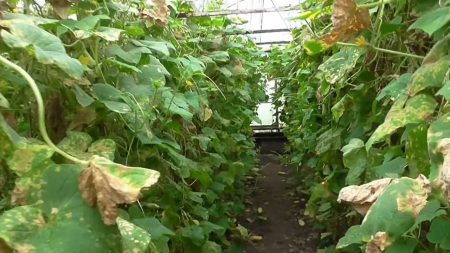
If you do not fight spider mites, the cucumbers may die.
| Content:
|
What does a spider mite look like?
Spider mites are classified as arachnids. This is dangerous cucumber pest and crops grown together with it.
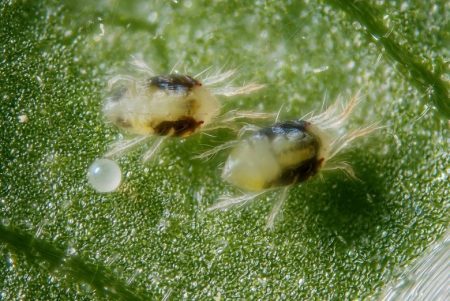
This is what spider mites on cucumbers look like when zoomed in
- Ticks have microscopic sizes: 0.3-0.5 mm, they are difficult to see with the naked eye. Males are always smaller than females.
- Depending on what species parasitizes cucumbers, the body color can be brown, greenish-yellow, red or reddish, gray.
- The larvae of any type of tick are transparent.
- Females overwinter under plant debris, in cellars and sheds, in greenhouse structures, manure and the top layer of soil in greenhouses.
- Pests reproduce at temperatures above 22°C and humidity no more than 65-75%. Under favorable conditions, mites can live and reproduce all year round (this is often found in industrial greenhouses). Under unfavorable conditions, tick reproduction stops.
- The female lays 1-3 eggs on the underside of leaves, plant debris or in the top layer of soil. One female can lay up to one and a half hundred eggs.
- Under favorable conditions, a larva emerges from the egg after 3 days. In unfavorable conditions, mite eggs can persist for up to 3-5 years (depending on the species).
- The life cycle of a tick depends on the environment. At temperatures above 30°C, arachnids go through all stages of development in 5-7 days, at temperatures of 25-30°C - 10-12 days. If the temperature is 20-25°C, then it takes 20 days from the larval stage to the adult.Under unfavorable conditions, the larvae are able to enter into suspended animation.
- Adult ticks live 15-30 days. The lifespan of individuals clearly depends on air temperature, and if they parasitize in a greenhouse, then on humidity.
- Both larvae and adults live and feed only on the underside of the leaf.
- On cucumbers, mites damage the leaves, and sometimes, if the pest is very widespread, they can feed on the flowers.
Under favorable conditions, about 10 generations of pests appear per season. Therefore, the fight against spider mites is not always successful.
Spread of spider mites
Spider mites can be carried by the wind, contaminated soil, or purchased seedlings. Plants purchased from nurseries are very often infected with mites. It is widespread there in greenhouses. Therefore, all purchased seedlings, before being planted in the country, need to be kept in quarantine in a bright and dry room for several days. Ticks, if there are any, will definitely show themselves.
Spider mites practically do not damage plants with pubescent leaves, since it is difficult for them to feed in such conditions. Arachnids never attack marigolds, calendula, onions, and garlic.
Of the wild plants, the pest does not attack chamomile, celandine, wormwood, tansy, yarrow, and dandelion.
The mite does not touch mustard, basil, or parsley. All other cultivated and wild plants suffer from spider mite attacks.
Overwintering pests in the spring initially feed on weeds and only then, when planting cultivated plants, they reach them with the wind, soil, through working tools and the clothes of the summer resident.
In greenhouses, when single-planting, cucumbers are very common and quickly spread throughout the plants.Therefore, you need to start fighting spider mites as soon as you discover the pest.
When grown together, cucumbers and tomatoes do not spread as quickly, since tomatoes are not a very desirable crop for them. They also damage it, but less often and not so severely.
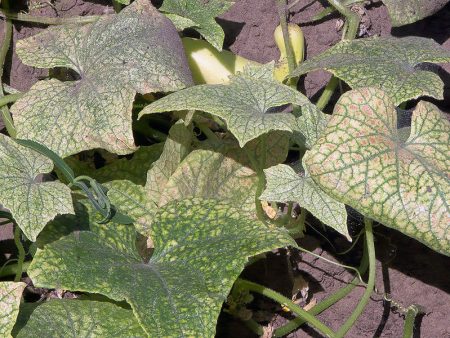
This is what the leaves of cucumbers affected by mites look like.
Nature of damage
- The most important sign that allows you to identify a spider mite is a thin web entwining the affected parts of the plant.
- Small light dots appear on the underside of the leaves - puncture sites. Over time, they become colorless, and if there are a lot of pests, then the points gradually merge, forming extensive necrotic areas.
- Marble-colored spots appear on the upper side of the leaves.
- When there are a large number of mites, the leaves turn yellow and dry out.
- In bright sunshine, gray and silver spots and streaks are clearly visible on the lower side - waste products of ticks.
Waste products of ticks.
In addition to damaging cucumbers, the mite is a carrier of various diseases, in particular the cucumber mosaic virus.
Ways to combat ticks in open ground
Measures to combat mites on cucumbers depend on the number of pests and air temperature. In open ground it depends entirely on external conditions. Therefore, outdoor cucumbers are always less damaged than in a greenhouse.
- At temperatures no higher than 23°C, the pest does not reproduce so quickly. Therefore it is possible use biological products.
- ExtraFlor preparation No. 11. It contains extract and essential oil of chamomile. The tick cannot tolerate the smell of chamomile, and the essential oil has a detrimental effect on already parasitic individuals. The period of protective action of the drug is up to 20 days. Does not accumulate in the soil.Begins to act 10 hours after treatment. ExtraFlor on cucumbers can be used at any stage of the growing season. To prepare a working solution, 1 g of the drug is dissolved in warm water, cooled to room temperature, and then filtered. After spraying, the greens can be eaten after washing them thoroughly. The treatment is carried out on the underside of the leaves. The drug is effective only when the number of pests is small and the weather is not very hot. In addition to arachnids, ExtraFlor No. 11 protects cucumbers from aphids, and on other crops it is used as protection against psyllids, bedbugs, whiteflies, and copperheads.
- Fitoverm is a biological product for protecting cucumbers from spider mites and aphids. It is also used on other cultivated plants as a means of combating thrips and caterpillars. The active ingredient of the drug is waste products of soil microflora. To treat cucumbers against spider mites, 4 ml of the drug is diluted in 400 ml of water. Plants are sprayed 2 times with an interval of 3-4 days. After processing, greens should not be eaten for 3 days. To process cucumbers, use a freshly prepared solution, since it cannot be stored. Solution consumption 1 l/10 m2. The period of protective action is from 7 to 20 days and depends on the activity of the pest and air temperature. A few hours after treatment, the ticks stop feeding. The death of arachnids occurs after 3-5 days. The drug should not be used in hot weather (30°C), since the pest activity is very high, and the drug is ineffective in such conditions.
- Other biological products: Vermitek, Actofit, Bitoxibacillin.
- ExtraFlor preparation No. 11. It contains extract and essential oil of chamomile. The tick cannot tolerate the smell of chamomile, and the essential oil has a detrimental effect on already parasitic individuals. The period of protective action of the drug is up to 20 days. Does not accumulate in the soil.Begins to act 10 hours after treatment. ExtraFlor on cucumbers can be used at any stage of the growing season. To prepare a working solution, 1 g of the drug is dissolved in warm water, cooled to room temperature, and then filtered. After spraying, the greens can be eaten after washing them thoroughly. The treatment is carried out on the underside of the leaves. The drug is effective only when the number of pests is small and the weather is not very hot. In addition to arachnids, ExtraFlor No. 11 protects cucumbers from aphids, and on other crops it is used as protection against psyllids, bedbugs, whiteflies, and copperheads.
- If the outside temperature is above 25°C, then biological products will not help, since the mite multiplies too quickly.In this case, chemical protective agents are used.
- Anti-mite is an acaricide used to combat spider mites. 1 ml of the drug is diluted in 1 liter of water, and the cucumbers are sprayed on the underside of the leaves. The period of protective action is 2-3 weeks. Processing is carried out once. If after spraying the pest appears again, then, in order to avoid the arachnids becoming accustomed to the active substance, the drug is changed. After processing, greens cannot be used as food for 5-7 days.
- The use of “killer” drugs: Sunmite, Flumite, Neoron, Apollo. These pesticides have a wide spectrum of action; they suppress many types of arachnids: red and brown fruit mites, spider mites, grape mites, and other species. They are effective at all stages of pest development - from larvae to adults, and also destroy arachnid eggs. Treatment is carried out in the morning or evening with a freshly prepared solution.
- Affected leaves are removed and burned.
When growing cucumbers in open ground, arachnids initially appear on the weeds and only then move on to the cucumbers. Therefore, weed control is the most important measure for controlling spider mites outdoors.
How to deal with pests in a greenhouse
- The pest's weakest point is that it cannot tolerate high humidity. Therefore, it is worth increasing it in the greenhouse to 80-85% and the arachnids will disappear. Under unfavorable conditions, they fall into suspended animation. But there is a downside: as soon as the humidity drops, the arachnids will appear again. In addition, high humidity contributes to the appearance of many cucumber diseases.
- Biological products in a greenhouse are ineffective because they act slowly.Ticks in closed ground reproduce faster than the drug works, so here they immediately use Anti-Tick, or Flumite or Sunmite.
- The interval between treatments of greenhouse cucumbers is 7-10 days. The frequency of treatments is at least two. This, again, is due to the high rate of reproduction of the pest in the greenhouse.
In a greenhouse, when a spider mite is detected on cucumbers, the fight against it must begin immediately, otherwise it can destroy all the plants in a week.
Traditional methods
- Using tomato tops to process cucumbers. 1 kg of tops is poured with boiling water, left for 24 hours and filtered. Add 20-30 g of laundry soap to the finished solution as an adhesive. Treatment is carried out on the underside of the leaves when the pest appears.
- Use of predatory spiders. They are sold in specialized stores. True, this is still rare, but some gardeners use this safe and effective method. Predators do not damage cucumbers; they feed exclusively on insects and arachnids, including spider mites. But here it should be taken into account that the cucumbers will be in a web, since all arachnids weave these “webs”. This exotic method is used only when the pest multiplies massively in dry, hot summers by fanatical fans of organic farming. The method is quite expensive, but effective.
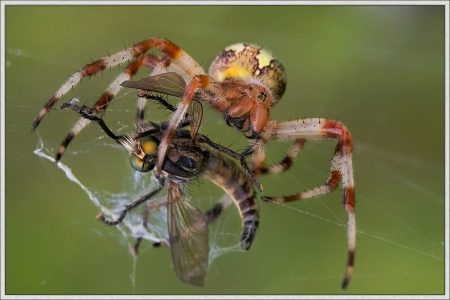
Such exotic control measures can also be used against ticks.
There are no other sufficiently effective folk remedies in the fight against ticks. Therefore, when a pest is detected, it is better to immediately apply pesticides.
Prevention
- Maintaining crop rotation in the greenhouse. Cucumbers are the pest’s favorite treat. He eats tomatoes, peppers and eggplants less actively.On tomatoes and eggplants, the mite has difficulty reproducing because the leaves of these crops have pubescence. The tick will feed on pepper last, if there is a lack of food supply.
- In open ground, crop rotation is also necessary.
- Mowing weeds around the perimeter of the greenhouse and borage, since the pest first settles there.
- Trim and burn any damaged leaves.
- Plant plants that repel the pest along the perimeter of the cucumber beds.
And yet, prevention does not really help in the fight against ticks, since they can be carried by the wind. It is necessary to inspect cucumbers every few days, and at the first signs of damage, use, at a minimum, biological products.
Personal experience with spider mites
- I rarely get spider mites in the greenhouse with cucumbers, because there is high humidity, which it doesn’t like. In addition, until mid-June, marigold seedlings grow there, the leaf secretions of which are not tolerated by ticks. When cucumbers and marigolds grew together, there were never any spider mites.
- After planting marigolds in the ground, pests sometimes still appeared on greenhouse cucumbers. If they have not yet spread, then I immediately remove the affected leaves and burn them. I dust the cucumbers themselves and the ground around them with ash or tobacco dust.
- If the moment is missed and the arachnids have already spread throughout the greenhouse, then I immediately use the “heavy artillery” - I treat it with Sunmite. It reliably destroys mites at all stages and well protects cucumbers from their reappearance.
- When arachnids appear in open ground, it is somewhat more difficult to control them.Usually, for prevention, I dust cucumbers with ash or tobacco dust, but this method is ineffective outdoors, since the protective dust is quickly washed off by rain or when watering.
- If a mite has already appeared in the borage, you have to treat it with chemicals. But here, with a small lesion, I first use biological products. They are quite effective, since the weather in our central zone, with its sharp changes from hot to cold, itself helps to reduce the number of pests. After spraying, I always water the cucumbers generously to increase the humidity inside.
In fact, fighting a pest is not so difficult, the main thing is to do it on time.
Other useful articles on growing cucumbers:
- How to effectively fight aphids using traditional methods
- How to cure cucumbers from diseases
- The leaves on the cucumbers are turning yellow. What to do?
- So how to properly care for cucumbers?
- And here are 10 more articles about agricultural technology for cucumbers
- The ovary on cucumbers turns yellow, what should I do?
- Why do cucumbers grow bitter?
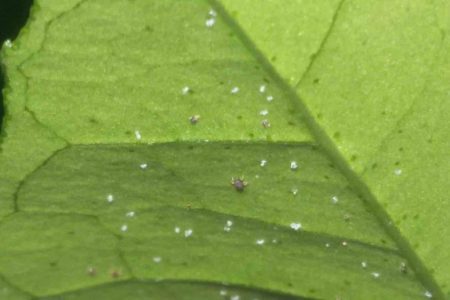

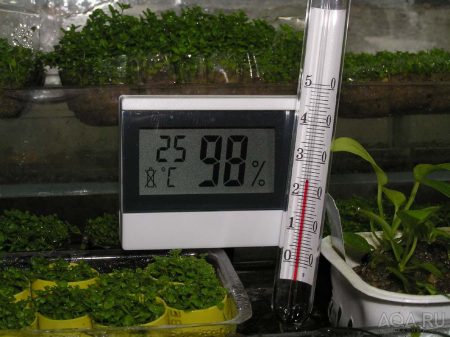

 (4 ratings, average: 4,50 out of 5)
(4 ratings, average: 4,50 out of 5) CUCUMBERS NEVER GET SICK, I'VE BEEN USING ONLY THIS FOR 40 YEARS! I SHARE A SECRET WITH YOU, CUCUMBERS ARE LIKE THE PICTURE!
CUCUMBERS NEVER GET SICK, I'VE BEEN USING ONLY THIS FOR 40 YEARS! I SHARE A SECRET WITH YOU, CUCUMBERS ARE LIKE THE PICTURE! You can dig a bucket of potatoes from each bush. Do you think these are fairy tales? Watch the video
You can dig a bucket of potatoes from each bush. Do you think these are fairy tales? Watch the video
 How our fellow gardeners work in Korea. There is a lot to learn and just fun to watch.
How our fellow gardeners work in Korea. There is a lot to learn and just fun to watch. Eye trainer. The author claims that with daily viewing, vision is restored. They don't charge money for views.
Eye trainer. The author claims that with daily viewing, vision is restored. They don't charge money for views. A 3-ingredient cake recipe in 30 minutes is better than Napoleon. Simple and very tasty.
A 3-ingredient cake recipe in 30 minutes is better than Napoleon. Simple and very tasty. Therapeutic exercises for cervical osteochondrosis. A complete set of exercises.
Therapeutic exercises for cervical osteochondrosis. A complete set of exercises. Which indoor plants match your zodiac sign?
Which indoor plants match your zodiac sign? What about them? Excursion to German dachas.
What about them? Excursion to German dachas.